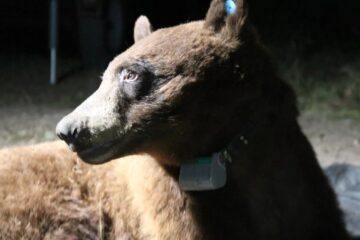Four Lion Cubs Are Born Free
The last two pumas in the Santa Monica Mountains have produced a litter, delighting scientists
Source of this article – Los Angeles Times, October 6, 2004.

BABY: One of the mountain lion cubs bom in August. The litter of four has tripled the cougar population in the Santa Monicas.
Talk about a couple who survived the odds.
The last known male mountain lion in the Santa Monica Mountains and the one known female in that range have parented a litter of four kittens, to the delight of National Park Service officers tracking them.
The pumas, known as P-1 and P-2, found each other last May during a several-day interlude amid the scraggly chaparral, said the team monitoring them through very high frequency radio transmitters and global positioning satellite gear on their collars. In late August, probably on the 20th, P-2 gave birth, said Seth Riley, wildlife ecologist for the park service in the Santa Monicas.
Two Thursdays ago, the park service team finally found the litter through the mother’s transmitter. After days of waiting for the mother to leave her den, the team came upon the quartet of mountain lion babies.
“We’re real excited about this,” said Ray Sauvajot, chief of planning, science and resource management for the Santa Monica Mountains National Recreation Area.
The kittens, tawny colored with spots and weighing between 2.5 and 10 pounds each, had transmitters implanted in their abdomens so Sauvajot and other team members can track their growth and progress in coming months.
That is when the most gripping drama may unfold.
The tracking is part of a study begun in 2002 to assess the effect of urbanization on mountain lions, the scope of their territory and whether the rapidly diminishing population in the small ranges, including the Santa Monicas, which are boxed in by development, can survive, Riley said.
In those two years, scientists from several government agencies and private nonproflts found P-l and P-2 in the Santa Monicas, the female in the Santa Susana mountain range and the male, whose territory followed a figure-eight pattern spanning the Susanas and Simi Hills.
Female pumas have smaller territories and tend to remain in the area where they were bom, Riley said.
Males are fiercely territorial, which fuels the belief that the 150-pound P-l has the Santa Monicas to himself.
As is characteristic of his species, P-l didn’t linger about the nursery and hasn’t visited once, the team members said.
To appreciate this new family, which triples the population of pumas in the Santa Monica Mountains, one must know P-l’s story.

NEW DADDY: P-l is believed to be the last male mountain lion in the Santa Monica Mountains. He mated with P-2, the last female, in May. P-2 gave birth in August to two females and two males.
In December (about the time a young male mountain lion was struck by a car in Malibu), property owner Brian A. Sweeney got a permit from a California Fish and Game warden to have P-l killed, because evidence showed the cat had killed several of Sweeney’s goats.
The permit alarmed state and federal park officials who had been studying P-l and P-2 and who feared the extinction of lions in the Santa Monicas.
The permit prompted officials to reconsider a state law that requires wardens to issue a permit to kill mountain lions after the confirmed loss of livestock.
Sweeney later said he meant only to have the lion scared, not destroyed, contrary to what other government officials maintained. He called off the hunt and let his permit expire.
Spared, P-l was free to roam, and in the spring he became interested in P-2, Riley said.
But this isn’t a Disney story. The scientists say the offspring have only a 50% chance of surviving a year in their limited habitat, although it is lush with vegetation and deer (of which the adults eat three or four a month). But P-l will soon view his two sens as rivals, and they will need to leave the Santa Monicas for their own turf, Riley said.
They will be forced to cross either the 101 or 118 freeways to reach neighboring mountain ranges.
“Will they make it? Where will they go, and where will that end up being? That’s the question,” Riley said. The cubs’ abdominal transmitters eventually will stop working, and scientists will need to equip them with collar transmitters, or lose track of them.
“The whole point of our study and our concern is protecting the thinning corridors they have to cross into other areas, because mountain lions need a lot of space for their home,” Riley said. “And if the connection is a freeway, will these kittens survive long enough for us to even put radio tracking on them?”


